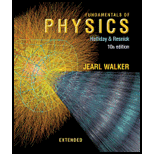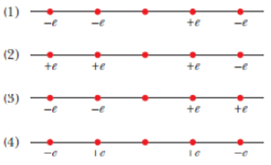
Concept explainers
Figure 21-11 shows (1) four situations in which five charged particles are evenly spaced along an axis. The charge values are indicated except for the central particle, which has the same charge in all four situations. Rank the situations according to the magnitude of the net electrostatic force or the central particle, greatest first.

Figure 21-11 Question 1.
To rank:
The situations according to the magnitude of net electrostatic force exerted on the central particle by four given particles.
Answer to Problem 1Q
Solution:
Rank based on net electrostatic force is F3>F1>F2>F4
Explanation of Solution
1) Concept:
The net force acting on a particle due to more than one particle is the sum of forces exerted by each of the particles.
2) Formulae:
Electrostatic force between two charges q1 and q2,
k- Coulomb’s constant constant=8.99 x 109
d- distance of separation between particles.
3) Given:
a. The five particles are evenly spaced on an axis.
b. The charges on four particles are given except for the central particle.
Situation 1: Charges on right side = -e, -e Charges on left side =-+e, -e
Situation 2: Charges on right side = +e, +e Charges on left side =+e, -e
Situation 3: Charges on right side = -e, -e Charges on left side =+e, +e
Situation 4: Charges on right side = -e, +e Charges on left side =+e, -e
c. The central particle has same charge in all the 4 situations.
4) Calculation:
Let us consider that each of the particles is located at d distance apart.
Let us consider that the central particle has a charge +e.
According to Coulomb’s law, the magnitude of force F acting on the central particle due to the particles at distance d is,
Situation 1:
In the situation 1, the free body diagram of force acting on central particle, due to other particles is drawn as shown below.
 |
||||||||||||||||
|
|
|
|
|
||||||||||||
The particles located at distance 2d on either side, exert equal and opposite forces on the central particle. So they nullify each other’s effect on the central particle. Meanwhile, the particles at distance d exert equal forces towards the same direction, and hence the exerted forces add up to 2F.
Hence net force, F1= 2F
Situation 2:
|
|
|
|
|
||||||||||||
Force exerted by particles at distance d on either side nullifies each other. Hence, the net force on the central particle due to the particles at 2d distance,
F2 =
=
=
Situation 3:
 |
||||||||||||||||
|
|
|
|
|
||||||||||||
Here the particles at distance ‘d’ exert equal force on same direction as in situation 1. Hence the force exerted by these particles on central particle is 2F. The particles that are at 2d distance on either sides again exert same force in same direction as in situation 2. Hence the force exerted by them on central particle is 0.5F.
Net force, F3= F1+F2 = 2F +0.5 F = 2.5 F
Situation 4:
 |
||||||||||||||||
|
|
|
|
|
||||||||||||
Here the particles at distance ‘2d’ nullifies each other’s effect and also that are at distance ‘d’ again cancel the force exerted by each other. Therefore, the net force acting on the particle is zero.
Net force, F4=0
Conclusion:
We can find net electrostatic force acting on a particle by knowing the magnitude and direction of the forces exerted by each of the particles present in the system.
Want to see more full solutions like this?
Chapter 21 Solutions
Fundamentals of Physics Extended
Additional Science Textbook Solutions
Biology: Life on Earth (11th Edition)
Campbell Biology (11th Edition)
Campbell Biology: Concepts & Connections (9th Edition)
Genetic Analysis: An Integrated Approach (3rd Edition)
Chemistry & Chemical Reactivity
Organic Chemistry (8th Edition)
- In the following figure the circuit to the left has a switch thatat t = 0 s is switched and disconnects the battery from the circuit. The state depicted on thefigure is right after the switch, still t = 0. As the current decreases over time, the magneticflux through the circuit on the right (due to the long cable of the circuit on the left) changesand induces an EMF on the right circuit. How much power is consumed by R2 as a functionof time.The distance between the wire on the left and the closest wire on the right is r = 2.0 cm.The size of the circuit on the right is noted on the figure.arrow_forwardsingly A samply ionized helium atom is in the ground state. It absorbs energy and makes a transition to the n=7 excited state. The ion returns to wo the wavelength the ground state by emitting SIX photons ONLY. What is the of the second highest energy photon ?arrow_forwardAn electron, traveling at a speed of 5.60x10° m/s, strikes the target of an X-ray tube. Upon impart, the eletion decelerates to one-third of it's original speed, with an X-ray photon being emitted in the process. What is the wavelength of the photon? m.arrow_forward
- Can you help me solve this 2 question and teach me what we use to solve thisarrow_forwardYou are working during the summer at a company that builds theme parks. The company is designing an electromagnetic propulsion system for a new roller coaster. A model of a substructure of the device appears in the figure below. Two parallel, horizontal rails extend from left to right, with one rail behind the other. A cylindrical rod rests on top of and perpendicular to the rails at their left ends. The distance between the rails is d and the length of the rails is L. The magnetic field vector B points vertically down, perpendicular to the rails. Within the rod, the current I flows out of the page, from the rail in the back toward the rail in the front. The rod is of length d = 1.00 m and mass m = 0.700 kg. The rod carries a current I = 100 A in the direction shown and rolls along the rails of length L = 20.0 m without slipping. The entire system of rod and rails is immersed in a uniform downward-directed magnetic field with magnitude B = 2.30 T. The electromagnetic force on the rod…arrow_forwardBased on the graph, explain how centripetal force is affected when the hanging mass changes. Does your graph verify the relationship in the equation r = x^i + y^j = r cos ωt I + r sin ωt^j?arrow_forward
- Can you help me to solve this two questions can you teach me step by step how to solve it.arrow_forwardGiven: ruler 11.56 g, small washer 1.85 g each, large washer 24.30g each Use the data in Data Tables 4 and 5 to experimentally determine the mass of your ruler. Use one of your 2 trials with 1 small washer at 0 cm, one of your 2 trials with 2 small washers at 0 cm, and one of your 2 trials with 3 small washers at 0 cm to find three experimental values for the mass of the ruler. How do you experimentalls determine the mass?arrow_forwardCompare the 3 experimental masses of your ruler to the measured mass of your ruler (Data Table 1) by calculating the percent error for each experimental value. Which trial provided the best data for determining the mass of the ruler? Please help, I am not sure how to calculate this. Thanks!arrow_forward
- Please help, everytime I try to input the data only one point shows on the graph. Please graph unsing centripetal force, Fc, versus V E2 from Activity 1. Include a line of best fit and record the equation of the line. Thank you!arrow_forwardPlease help, everytime I try to input the data only one point shows on the graph. Graph of centripetal force, Fc, versus V E2 from Activity 1. Include a line of best fit and record the equation of the line.arrow_forwardBased on your graph, explain how centripetal force is affected when the hanging mass changes. Does your graph verify the relationship in the equation r = x^i + y^j = r cos ωt I + r sin ωt^j?arrow_forward
 Physics for Scientists and Engineers: Foundations...PhysicsISBN:9781133939146Author:Katz, Debora M.Publisher:Cengage Learning
Physics for Scientists and Engineers: Foundations...PhysicsISBN:9781133939146Author:Katz, Debora M.Publisher:Cengage Learning
 Principles of Physics: A Calculus-Based TextPhysicsISBN:9781133104261Author:Raymond A. Serway, John W. JewettPublisher:Cengage Learning
Principles of Physics: A Calculus-Based TextPhysicsISBN:9781133104261Author:Raymond A. Serway, John W. JewettPublisher:Cengage Learning Physics for Scientists and Engineers with Modern ...PhysicsISBN:9781337553292Author:Raymond A. Serway, John W. JewettPublisher:Cengage Learning
Physics for Scientists and Engineers with Modern ...PhysicsISBN:9781337553292Author:Raymond A. Serway, John W. JewettPublisher:Cengage Learning Physics for Scientists and EngineersPhysicsISBN:9781337553278Author:Raymond A. Serway, John W. JewettPublisher:Cengage Learning
Physics for Scientists and EngineersPhysicsISBN:9781337553278Author:Raymond A. Serway, John W. JewettPublisher:Cengage Learning College PhysicsPhysicsISBN:9781938168000Author:Paul Peter Urone, Roger HinrichsPublisher:OpenStax College
College PhysicsPhysicsISBN:9781938168000Author:Paul Peter Urone, Roger HinrichsPublisher:OpenStax College





